Vintage 1970s Photos Show Lost Sites of NYC's Lower East Side
A quest to find his grandmother's birthplace led Richard Marc Sakols on a mission to capture his changing neighborhood on film.


There’s an uneasy tension in Washington D.C. that you can feel palpably on the streets. More than just new buildings going up and cranes dotting the skyline, architecture (or perhaps the uniformity of it) has been a strong signal of the type of change that is en route. As gentrification begins to reach neighborhoods that were thought beyond the reaches of such socioeconomic change, residents are getting nervous.
In many ways, the 5×5 Project in Washington D.C., a 3 1/2 month temporary public art project, highlights this tension and explores it. 5 curators each worked with 5 artists to produce site-specific work in all eight wards of Washington D.C. While the DC Commission on the Arts and Humanities sponsored the project, the artists selected their own sites. As such, the locations are ones that the artists themselves responded to in their immersion into Washington D.C., and some of the works clearly reflect the psyche of what is currently happening in D.C. Washington D.C. has clearly supported large-scale public works art part of their ongoing heritage, enabling the artists to install creative works nearly anywhere, including a kinetic sculpture of a hat blowing in the wind that happens just every Wednesday at noon on a street near Federal Center.
Here is a highlight of some of the most interesting pieces:
Bridge by Glenn Kaino, curated by Shamin M. Momim
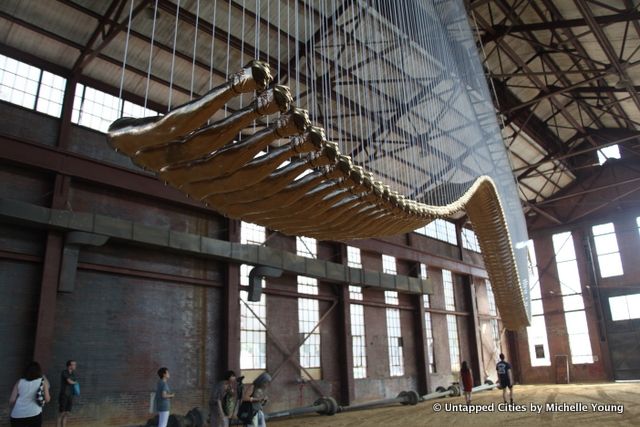
In an industrial building at the DC Navy Yard that currently houses a handful of vintage lampposts, Glenn Kaino has created a golden piece akin to a massive harp. On closer inspection, the gold pieces are the arm and fist of athlete Tommie Smith, the gold medal winner of the 200 meter event at the 1968 Olympics in Mexico City, whose gesture became the ubiquitous symbol of the Black Power movement. In this piece, Kaino explores the power of cultural memory and its reconfiguration and dissipation over time.
Just next door, a building complex that had a served as an informal graffiti mecca in Washington D.C. had been cleared for redevelopment further highlighting the changes in the DC Navy Yard and Washington Nationals stadium area. Contained as the piece was and on the border of gentrified housing, the location nonetheless had some significance–200 golden arms at 200 Tingey Street SW, and a coincidental 200 meter event in 1968.
Interior Sketch by Diana Al-Hadid
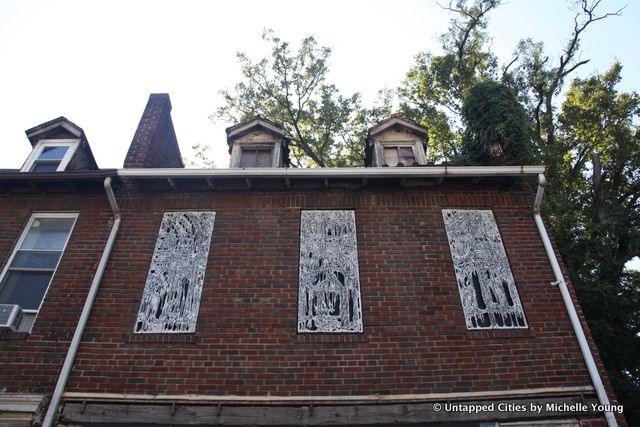
The experience in Anacostia however, was a very different story. The neighborhood tells the story of many urban centers in the mid-20th century. Once one of the first suburbs of Washington D.C., the neighborhood was built for working class whites in the mid 1800s. Then the Anacostia Freeway was constructed, separating the neighborhood from the waterfront, and public housing projects were built. Suburban white-flight followed and the neighborhood became, as it is today, predominantly African American.
Diana Al-Hadid’s work, Interior Sketch, uses an abandoned buildings. She replaced the plywood boards that covered broken windows on the second floor and created a triptych of gypsum, fiberglass, and steel. On one hand, the piece recalls the existing nature of the abandoned building–a piece that is easy to miss unless you are both looking up, and looking closely. At the same time, the piece is supposed to be “suggestive of Baroque cathedral architecture” and “evok[ing] majestic built architecture,” according to the press release. It leaves the viewer to wonder what assumptions have been made about what majestic architecture should be–the vernacular or something imported from another country and another era? Regardless, it is certainly a piece that has been embedded into the site in a subtle way.
The neighbors were less than taken with the works (an A.M. Weaver curated billboard that’s part of “Ceremonies of Dark Men” in the 5×5 Project is just across the street). The sign in front of Al-Hadid’s work was stolen and residents were vocally upset by our visit, highlighting the city-wide unrest about residents getting pushed out.
Construction by Marley Dawson, curated by Justine Topfer
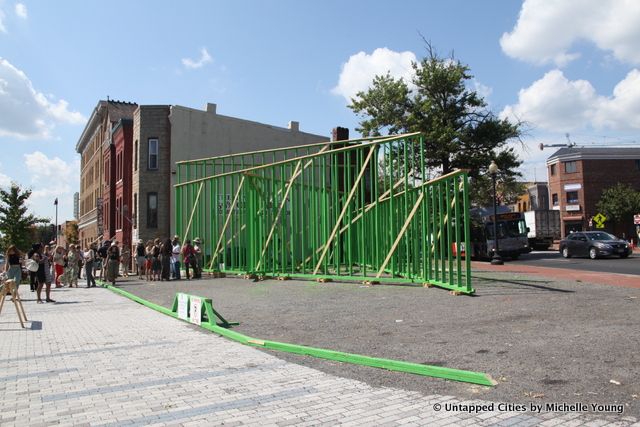
Situated at a triangular-shaped intersection, Construction takes over a former parking lot and was constructed on site. The wooden beams are meant to recall the fabrication process of rapidly constructed, wood framed housing developments that have been going up all over Washington D.C. As described, “these developments, sometimes chad cheaply in brick veneer, appear as material illusions that fit in with the surrounding architecture even as their existence undermines it.” Perfectly sited between an already gentrified Wonder Bread factory redevelopment and wary neighbors, Construction also is based on the plans from a home of the artist in Australia.
Nonuments, Curated by Lance Fung
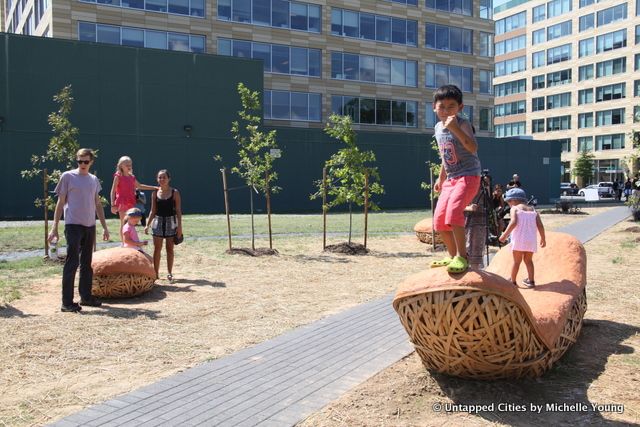
Trees planted as part of Peter Hutchinson’s Thrown Rope for Trees for Washington D.C. piece. with Michael Kolliner’s Nonumetnal Seating made in a communal mud dance
On 4th Street SW, curator Lance Fung and his artists have transformed an abandoned lot into an activated space with five works. Of the sites we visited, this seemed to have the most transformative effect on the space and community because of its collective curation. As Lance described at the event, the goal was to figure out how to “fill a lot [to be] vibrant, attracts a lot of people, but that’s still art at the end of the day…[the residents] are here day and night, because they have no idea what any of this is.” Nonuments is aimed at exploring current issues, in tribute to the “common man and to the ideals of democracy.”
Human trafficking is explored in Peep by Jonathan Fung, utilizing the shipping container as a referent to the common mode of transportation for victims of the trade. On one side, windows have been cut open to show rows of sewing machines to symbolize forced labor, combined with a sound installation of never ceasing machine motors. On the other side hang hundreds of wooden children blocks, to reflect stolen childhoods.
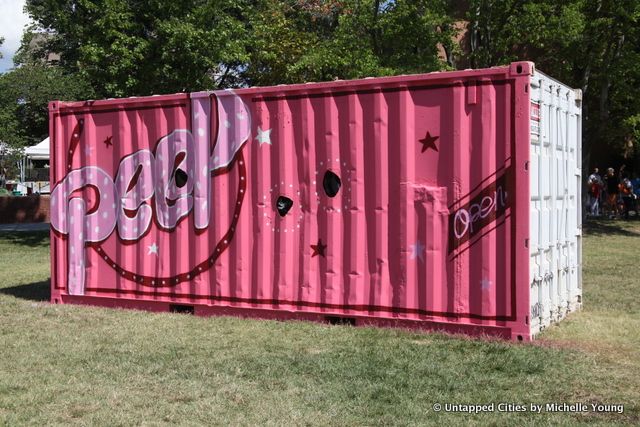
Jennifer Wen Ma has painted the face of a community member in black Chinese ink, celebrating the unsung heroes of daily life:
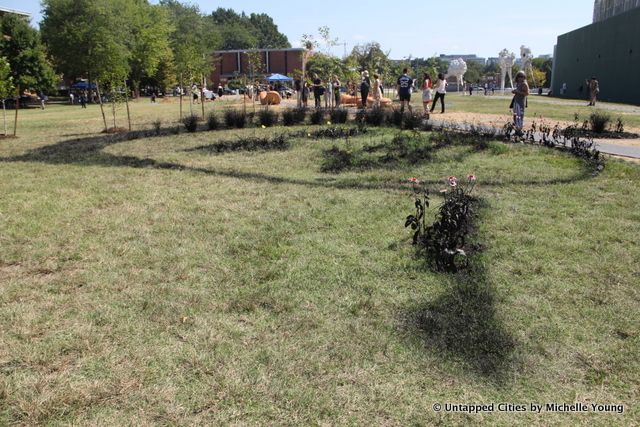
Migration, the largest pieces of the curation directly addresses gentrification and neighborhood change via oversized bird nests. As described, “Migration is a ‘nonument’ about leaving and finding a home in a time of dramatic social and climactic change…The nests are much like neighborhoods now on the move, embracing, adapting, or resisting forces of gentrification now sweeping the city, and the world.”
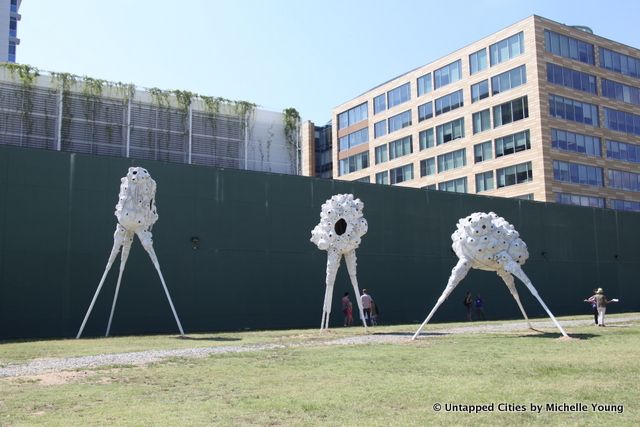
For 30 days six weeks, Naranjo-Morse and her team will be digging the site in a performance art piece that reflects different aspects of American culture. Participants digging will wear different costumes to represent the service industry, business class, farmers, criminals and more. At the end the process, the earth will be re-leveled.
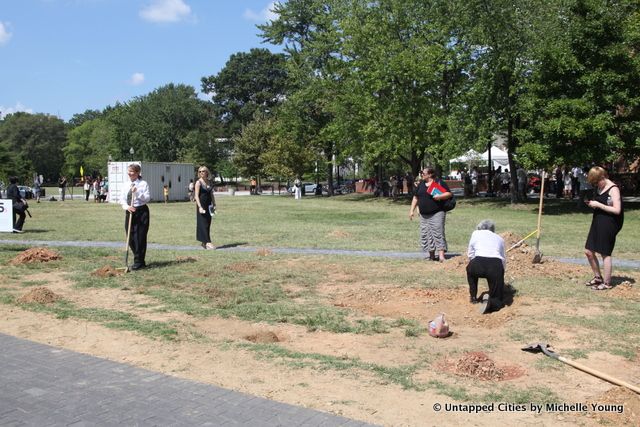
The pillow-case making area highlights the move to #EndtheQuota on forced immigrant detentions:
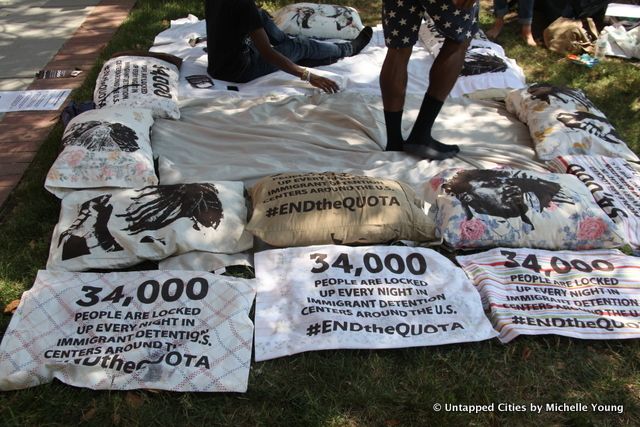
Looking Back by Decoy (Dignidad Rebelde), curated by Stephanie Sherman
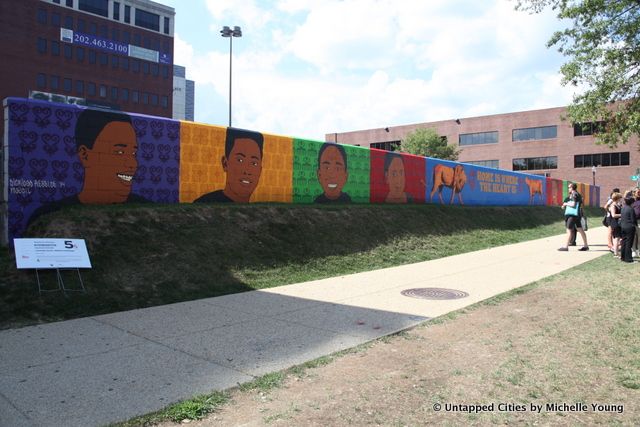
On a separation wall on 1st Street and N Street in NoMa, DC-based artist DECOY (Dignidad Rebelde) explores the impact on recent housing policies and redevelopment will impact future generations. Portraits of community youth feature on the graphic mural and on the screenprinted works DECOY produces on site for the community:
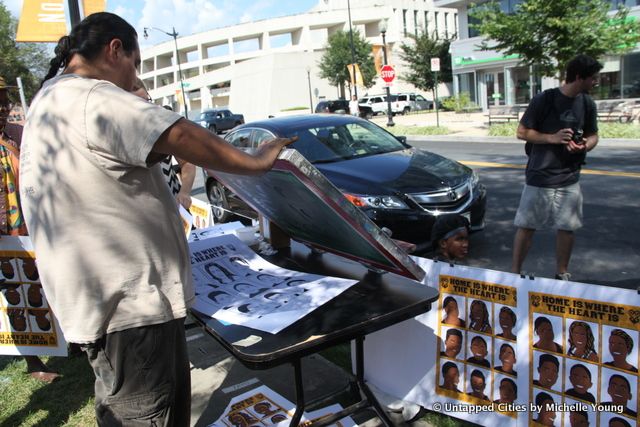
There are many more exhibits all around Washington D.C. that will be on site through December. The 5×5 aims to activate spaces, showcase works of art, provide opportunities for artists to experiment, build relationships with the community and bring together local and international artists.
Subscribe to our newsletter